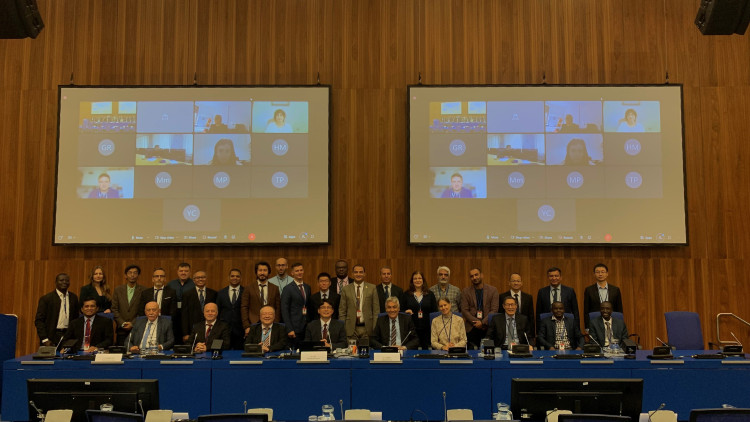Successful Integration of Safety Review and Capacity Building within the IAEA SEED Service
SEED project meeting hosted at the IAEA headquarters in Vienna, Austria, October 2023. (Photo: H.W. Lee/IAEA)
Fifty participants from 29 countries discussed the progress of the SEED (Site and External Events Design) review service and the capacity building programme on the site and design for nuclear installations, during a recent technical meeting at the IAEA Headquarters in Vienna, Austria. Specific draft documents that related to SEED, were also assessed. The meeting focused on improvements to be implemented, based on the feedback of experiences of countries, including the seven pilot countries — Egypt, Kazakhstan, Kenya, Morocco, Nigeria, Poland, and Uzbekistan.
The new revised and enhanced structure of the SEED guidelines document was also presented to the participants. It includes guidance on how to conduct a SEED workshop, types of training that will enhance the safety of nuclear power plants, self-assessment questionnaire as well as areas covered by SEED review missions.
“The SEED programme, backed by its updated guidelines and all-encompassing training endeavours, stands as proof of the collective dedication to ensure the safety and sustainability of our support to countries interest in nuclear power programmes to meet the increased energy demands,” said Paolo Contri, Head of the IAEA External Events Safety Section.
Achieving consensus on the training documents and SEED guidelines was among the main objectives of the expert meeting that took place from 9-13 October 2023. National presentations gave an insight on the education and training conducted on nuclear site safety for regulatory bodies in embarking countries. The exchanges also covered other IAEA working documents including ‘Self-Assessment Questionnaires for Site Selection and Evaluation’, and ‘Hands-on Practice Module for Site Safety Review.’
The IAEA, External Events Safety Section (the EESS) supports Member States, upon request, to achieve a high level of safety in relation to external events such as earthquakes, floods, typhoons, landslides, and events induced by human activities, which is undertaken by means of safety reviews, advisory services and capacity building based on the IAEA safety standards and technical documents. “Capacity building is instrumental in this process and reflected as an integral part of the SEED mission planning,” said Contri.
The EESS extra budgetary project
Recently, the IAEA has embarked on a revision of the SEED guidelines with the objective of streamlining its site and design review processes and enhancing capacity-building services, all under the framework of a specific EESS project aimed to pursue the integration of capacity building and a safety review service successfully.
Since 2020, the EESS has been implementing activities under an extra budgetary project that is co-funded by the European Commission and various Member States. This project played a vital role in supporting site-safety-related capacity building to countries embarking on nuclear power programmes to meet their energy demand and include — e-learning tools, self-assessment and training documents, as well as country-specific and training workshops.
Hyun Woo Lee, the Project Manager said that: “the project deliverables have been developed, tested, and optimized through consultancy meetings and national and international training workshops with seven pilot countries.” Experts’ support provided by Argentina, Hungary, Israel, Pakistan, South Korea, Türkiye, United Arab Emirates, United Kingdom and the United States of America has also enabled tangible outcomes from the training activities conducted to increase awareness of safety in site selection and design as well as the importance of knowledge and skill sharing in this specialised area.
In his remarks, highlighting the importance of such exchanges, Kenneth Anakoli, Head of Mombasa Regional Office from the Nuclear Power and Energy Agency in Kenya said: “through specialized training as a pilot country, we have gained invaluable expertise in crucial areas like regulatory competence for nuclear site safety, siting authorization process for nuclear installations, hydrological hazards and assessment, hands-on practice on safety analysis report and site evaluation report preparation, and public involvement. This knowledge empowers us to navigate complex processes, conduct informed siting studies, and positions our nation as a knowledgeable and capable authority in ensuring nuclear safety and compliance.”
Romania has also joined the ranks of pilot countries benefiting from the SEED review and capacity building programme. With their pursuit of small modular reactor (SMR) technology, the SEED programme will play a pivotal role in assisting Romania as they embark on this innovative path.
SAR review guidance document set to launch in 2024
A significant milestone was reached during the meeting with the successful completion of the Safety Analysis Report (SAR) Review Guidance for Site Characteristics. This guidance is scheduled for publication in 2024 and is expected to serve as a valuable reference for both regulators and interested organizations in Member States, particularly those embarking on their first nuclear programmes, in the establishment of their own SAR review procedures.
This document was presented by Aybars Gürpinar, Member of International Nuclear Safety Advisory Group (INSAG), who said: “The Safety Analysis Report (SAR) Review Guidance is a tool for the Regulatory Body for an effective and efficient review process of the SAR. In its preliminary form (PSAR) the document is one of the prerequisites for receiving the construction permit. A well-prepared SAR Review Guidance will provide for a robust review as well as a review which can be optimal in terms of required time. Similarly, the Final Safety Analysis Report (FSAR) is one of the important prerequisites for operation license and review guidance of this report will facilitate the review process.”

Participants at the technical meeting on the Site and External Events Design (SEED) Review Service and Capacity Building Activity Output Assessment at IAEA headquarters in Vienna, Austria, October 2023. (Photo: H.W. Lee/IAEA)
Since the first mission to the Philippines in 1978, Site and External Events Design (SEED) review service has been conducted in over 50 countries to assist Member States in their efforts to comply with IAEA safety standards.






